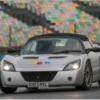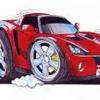Jaguar Cars Coventry
Unfortunately no photography or mobile phones were allowed in the plant at Coventry, whish is a shame as a picture is worth a thousand words! You’re only going to get a few hundred out of me today.
I hadn’t realised that Jaguar do tours twice a day, and this showed in the superb organisation. Firstly we had a ten minute long multimedia presentation on the history of the marque, it’s current position and future. This was projected onto two giant screens simultaneously, which were angled into a shallow V. I thought this was a bit unusual until the end of the show at which time both screens silently glided backwards and sideways to reveal a two-story exhibition! WOW! The lower exhibition was about the history of Jaguar and manufacturing plants, R&D and their approach to technology and quality, whilst the second floor was dedication to Formula 1. After 10 minutes or so we were given reflective waistcoats to wear before being taken into the factory in small groups by ex-production staff tour guides.
There are two production lines running. Interestingly both cars are still assembled by hand, although they have all the required kit to make life easy. We were given the option of seeing one type or both being produced. Our group opted for see both. The XK line runs at a far slower pace to the XJ, but then they only produce about 32 cars a day. It’s a fairly relaxed production environment, but what is clear when watching, is that they all care about how they assemble the cars. Apparently quality is the responsibility of each individual and they do not have a foreman watching over production. All the cars are built to order, so every specification attached to the bonnet is different. We were seeing LHD and RHD cars, XK8’s and Supercharged XKR’s being manufactured side by side.
It was particularly impressive to see the XKR body being lowered onto the lower chassis engine and transmission assembly. The 4.2 litre V8 Supercharged engine is massive and no wonder it took several hours for a minor repair to a breather pipe on mine, as there is no room to work on the beast without taking it out.
Within the plant they have an impressive modern woodworking factory to do the veneers. Amazingly, there is no wood dust in the atmosphere due to a massive air filtration system. They also produce the wood finished for Aston Martin.
One factory, which relies on traditional skills, is where they do all the leatherwork. This area was definitely low tech! The quality control and craftsmanship was good to witness. We were given a complimentary piece of leather embossed with the Jaguar logo as a memento.
We were then taken to the end of the production line where they do the final QC. Again, their attention to detail was very impressive. There was no rushing around bashing out the next car. The cars arrived on a slow line giving the testers plenty of time to do a thorough job. There were one or two cars that had failed QC. These were given priority stickers and put to one side for a specialist to take care of.
The tour ended at the Heritage museum where they were unloading an R type concept car as we arrived. I got a few shots including the SVO XKR, the Shaguar and two F1 cars. After lunch in boardroom luxury, we left to make our way the Milton Keynes with eager anticipation!
SVO one off

Close up of R type wheel concept


Wouldn't mind having my motor tooled up like that

Jaguar Formula 1 factory Milton Keynes
As you can appreciate, they are super-sensitive about no photography, however I did manage to get some shots at the end of the tour.
They have two CAD departments. We started our tour in the less restricted CAD department. First thing that stuck you was how young most of the staff members were. They are mainly graduates within the automotive industry who are up on the latest 3D modelling and design techniques. There’s not much to actually see, but it was explained to us that design is on going on the current R5 car and that in October parts for next years R6 car will be tested on a hybrid R5 car at races.
Many of the departments were simply off limits to outsiders. However, they did allow us a peak into seeing a system that cuts out fluid plastic parts by blue laser. These parts are used on a small-scale model for wind tunnel development. They only have a limited budget for use of the tunnel at Bicester for 8 hours a day, whereas Ferrari run theirs 24/7.
There are impressive milling machines in use including some which use 5 axis which means they can basically machine a part form a solid block without stopping. Many of those parts are actually moulds for carbon fibre components, like suspension. They were quite proud about how much lighter most components have become, not only through carbon fibre but using exotic metals including extensive use of titanium. It was explained that actually they have gone beyond the need to make the car lighter, BUT by making it even more lighter, it gives them more options moving weights around the car to get a better set-up. For that they use the heaviest metal available (can’t remember the name – begins with a D).
Surprisingly when one of the cars gets smashed up, they repair many of the carbon fibre parts as explained to us by the build manager. The poor guy’s heart sinks every time he sees a "Gav" as that means extra pressure to get parts repaired in advance of the next race. Even though they have an impressive machine shop what they produce is so specialist that if they do not have the capacity to make new parts quickly enough, it has to be sub contracted. A part that would normally cost £5000, suddenly becomes £30,000 when the sub contractor knows they are in the sh*t and need it in time for the next race!
They use special Dupont paints on body parts to save weight and help aerodynamics. The corporate logos are incorporated into the finish and are not stickers you would see on ordinary racecars. They spend £150K a year on paint for a handful of cars!

There’s a team of 8 working in the electronics department who develop the steering wheel. Each steering wheel costs a staggering £35K. It has a special anti reflective display to show numerous read-outs and there are several knobs which allow the driver to alter set up on the fly - Things like brake balance and hydraulics. There are the usual up and down gearshift paddles and a clutch paddle, which works exactly the same as a normal car that they use for the start of the race and pit stops. They would not let us hold the wheel.
Can you guess what they do here?

The last part of the tour was in the final race prep area. Three cars were being prepared for the next race at Spa. It was very interesting to get up close to these cars in various levels of undress, so to speak. The spare car was almost fully assembled, the other two had engines and gearboxes/back ends in various states of assembly. The bit you don’t see on TV is the engine separated from the car. This leaves the car looking really “bling†in the form a large amount of gold heat insulation separating driver/fuel tank and engine. I wish I could have got some shots of this to share with you.
There were also two other R5’s just lying around. One of them being the one which Martin Brundle drove in London recently. I could move this car with my little finger, which was incredible to me especially as I was pushing a million quid’s worth!



The top car shows wind resistance and downforce using colour

All in all I had a most interesting and enjoyable day seeing old world craftsmanship at one end of the scale, and the highest of high tech at the other.























